Respawn and Electronic Arts managed to keep Apex Legends a secret for a while. But rumors leaked out in the last few days, and the companies confirmed today they are launching a new battle royale game in the Titanfall universe. The surprise is that it is playable today for everybody, as the free-to-play game goes live on EA’s Origin platform.
I went to Los Angeles last week and tried out the game for several hours. Then I interviewed Mackey McCandlish, Respawn’s design director for Apex Legends. The game bucks some of the conventions of battle royale, as it has only 60 players overall and three players in each squad. But it’s a lot of fun, loads fast, and it has a lot of its own unique quirks.
McCandlish explained why Respawn’s team, which “chased the fun,” made certain design decisions and operated in complete stealth until the past few days. And, as Respawn CEO Vince Zampella also did, he explained why the Titanfall universe game has no Titans. They told me that they accepted some of the conventions of battle royale and they defied others, like the notion that you have to have 100 players in the game. (Apex Legends has only 60). The result is a fresh take on battle royale.
June 5th: The AI Audit in NYC
Join us next week in NYC to engage with top executive leaders, delving into strategies for auditing AI models to ensure fairness, optimal performance, and ethical compliance across diverse organizations. Secure your attendance for this exclusive invite-only event.
I found their design philosophy to be fascinating, and it was pretty impressive that the team got the game ready to launch in just 21 months.
Here’s an edited transcript of our interview.
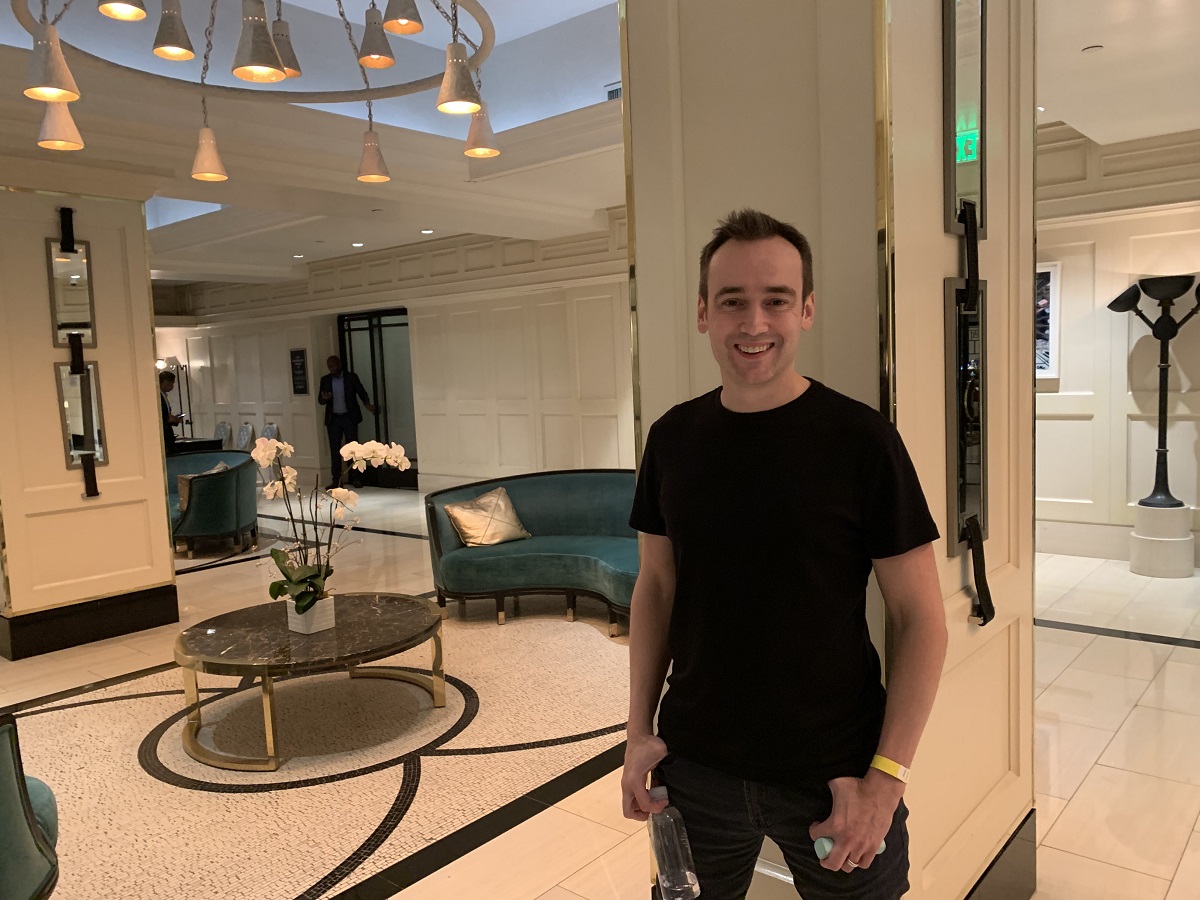
Above: Mackey McCandlish is design director at Respawn on Apex Legends.
GamesBeat: How long have you been working on this? From the beginning?
Mackey McCandlish: Oh yeah. I’ve been working with the same core of people for my entire career. It’s taken various forms. It’s merged with other teams, leading to where we are today.
GamesBeat: Did you come off of Titanfall 2 onto this?
McCandlish: We started before Titanfall 2 shipped. We had guys whose work was essentially finished for Titanfall 2. They were creative and they were dying to get started on the next thing. By the time we were in September 2016, we were doing initial action blocks for where we could go next.
GamesBeat: This morning they said you guys were chasing the fun, just sort of getting drawn toward PUBG and the battle royale excitement.
McCandlish: We’re fans of a lot of genres. We’re fans of survival in general. We were experimenting with survival game modes in 2015 for Titanfall 2. We eventually discovered other modes like bounty hunt that we shipped with Titanfall. But by the time PUBG blew up in March 2017, we were already exploring bigger maps and a lot of other ideas. It crystallized a major opportunity.
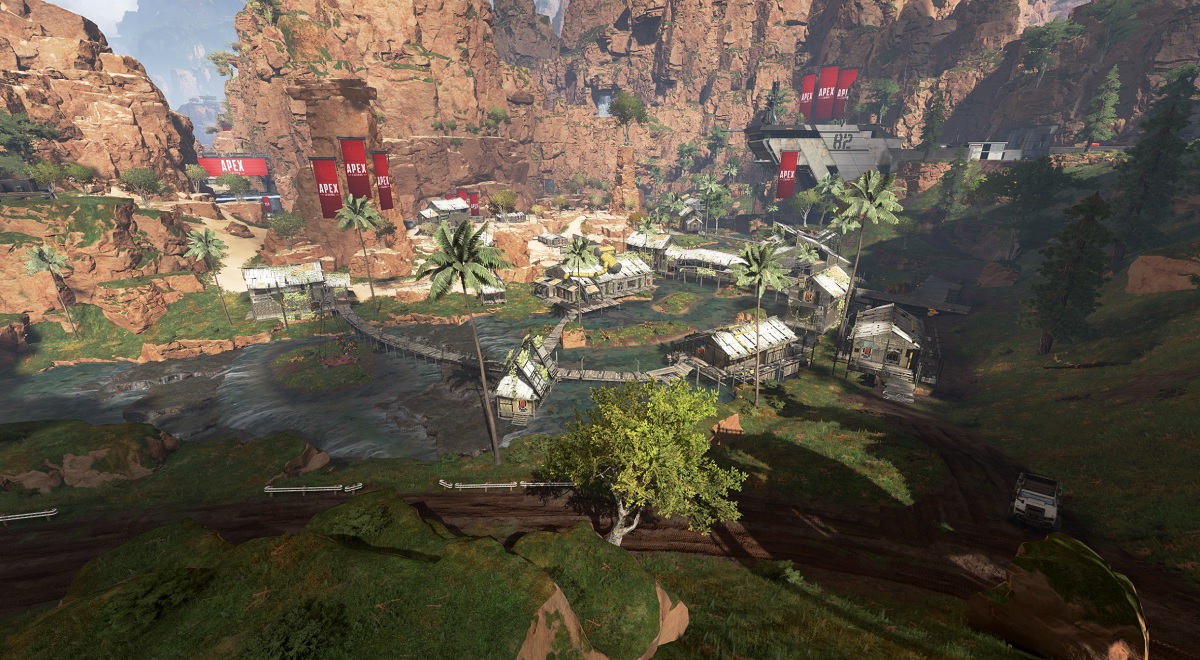
Above: 60 players can drop into the Apex Legends map.
We identified very early that this is a new genre, not just a mode. As such, it’s a disruptive opportunity to claim some of the genre space for ourselves. It’s much more challenging. All the credit to Overwatch for taking an established space and finding a new twist on it. Titanfall did similar work with a team deathmatch game there. But it’s different when you’re in a blue sky like battle royale, where it’s new.
GamesBeat: What do you think this has that’s new, that other battle royales don’t have?
McCandlish: It’s a rapidly maturing genre. We identified, through our wide prototyping, that there was opportunity within the squad, social space. We already knew we wanted to be social and free to play before PUBG came out. We were looking at games through the social, free-to-play lens. Squad play, specifically the three-man squads, gave us a chance to make a game that’s more about you and your teammates and less about being alone on a team, which is what some team deathmatch games tend to suffer from. We knew we wanted friends playing with friends.
Looking at the genre through that lens, a lot of side effects, secondary effects flow out of that. We have respawn chambers. Hey, my friend died. I don’t want us to all have to suicide now or wait until my next match. That happens in battle royale games. So can we make a mechanic where it makes sense to bring a player back in? You might not do that if your game is not social and squad-based.
We have characters. The characters have abilities that are squad-friendly. Lifeline can revive you faster. She has a shield. It’s helpful having a Bloodhound that can tell his teammates that somebody’s been here, or Pathfinder to put down a zipline you can ride. On top of that we have our smart comms to let you communicate efficiently with each other. You might not put all that energy into making a great communication system if your game is solo-centric.
GamesBeat: It loads fast, at least now. We’ll see when it launches. But is there something different about how you did loading to get the game going faster?
McCandlish: Again, this is a fresh genre. It’s a young genre. It has conventions. But since it’s a young genre, you have to look at each convention from first principles and say, “Is that just because it happened to be that way? Or is that the best way?” In genres that are 10 or 20 years old, a lot of that has been figured out. In a new genre, yes, we were playtesting — we had the same problems anyone else has. You go to a staging ground and you have to wait for everyone to connect. But that wasn’t better.
We said, “Okay, let’s do all the loading before you get in. Let’s change up how the engine works.” We can do that. It made the game better. Let’s make some other things in the game better. Let’s make inventory better. Let’s make looting a death box easy. Let’s make it so the attachments don’t all fall off. Let’s make it smart about whether to pick up the attachments.
I think a lot of the current innovation in battle royale has been coming from attempts to bring it to mobile, what it takes to make it playable on a phone. There’s still a lot of space out there. Getting you past the staging ground mentality is just one example.
GamesBeat: I didn’t understand some of what was happening. I remember a message saying that if I pick up this rifle, I have two compatible components for it. Does that automatically click on when I pick it up?
McCandlish: It’ll show you where it’s going to fit on, and then in cases where there’s a value judgment to be made — sometimes a short-range scope is actually better than a long-range scope, because you know you’ll be fighting in a smaller circle. In that case, the game doesn’t pick one or the other for you. It just illustrates, this is what the exchange will be. In cases where one is strictly better, like a level two down shield compared to a level one, or a level two full armor, it just won’t let you pick up the other one. It’ll stop you.
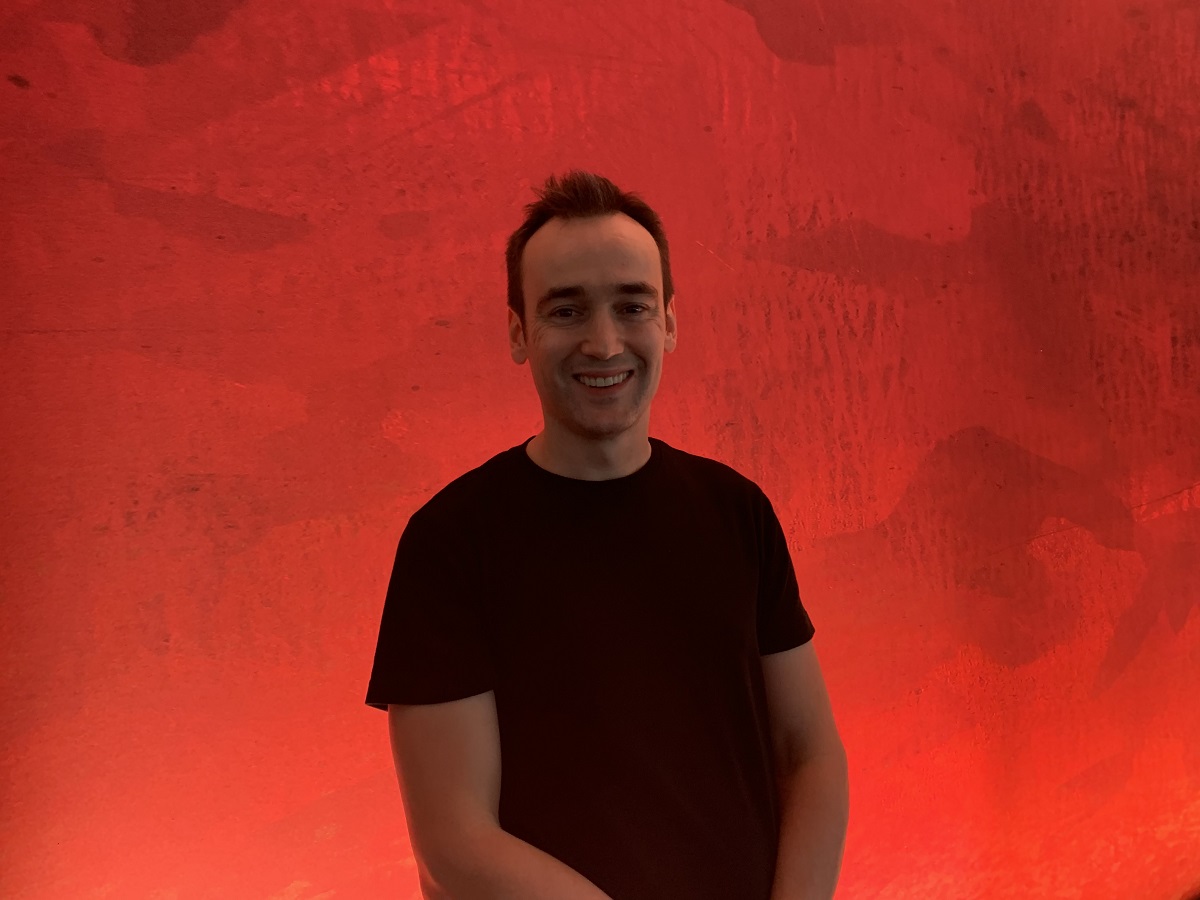
Above: Mackey McCandlish is design director at Respawn, has worked on all the Titanfall games.
GamesBeat: The smaller scope, with three squad members instead of four and 60 players instead of 100–it looks like a smaller map, too, right?
McCandlish: Yeah, it is.
GamesBeat: What led you there?
McCandlish: We’re the same team that chose to make Titanfall and Titanfall 2 have the player counts they did. It’s about what’s right for the game, not what is a given because of genre convention. We knew we had a team that was great at making arenas, fun spaces to explore and master. We weren’t coming from teams that make huge fields and endless terrain. We chose to develop ideas around intimate arenas that are connected through a fun slide mechanic to make traversing fun. That was just more befitting of a 60-person player count with three-man squads.
There’s a lot of subtleties to how three plays out versus four, but the big one is, there’s more opportunity for the one to defeat the remaining players than there is a four-on-one. There’s less snowballing. We wanted players to have more chances to win. Three players out of 60, that’s one in 20, a five percent chance, instead of just one.
To allay any fear, it wasn’t like we couldn’t do 100 players engine-wise. There were a lot of things we couldn’t do engine-wise when we started this, and we addressed the ones that were important to making this game.
GamesBeat: I don’t know if this is something you have to be aware of, but Battlefield V may have battle royale soon as well. Did you deliberately go in a different direction than you thought they might? They’re supposedly doing 60-ish as well.
McCandlish: I haven’t played theirs and I don’t know what their specific plans are. But I’d say we knew we needed to create and carve out a defensible space for our game, something our competitors couldn’t just copy and paste into their own games. When we announced Titanfall at E3 in 2013, our competitors said, “Okay, we’ll put high mobility in our games this year, and next year we’ll get wall-running in our game.” It feeds into why we’re doing something you can play right now, the moment you find out about it.
We identified that characters would be a defensible space. You can’t take our characters and put them in your game. We can’t use our competitors’ characters in our game without feeling like a cheesy rip-off of that character. We’re intimately arena-based. We’re not a big landscape, vehicle-based game. We looked for places where we could make something unique and easy to remember, something defensible. Great communication, three-man squads, intimate maps, and specific characters.
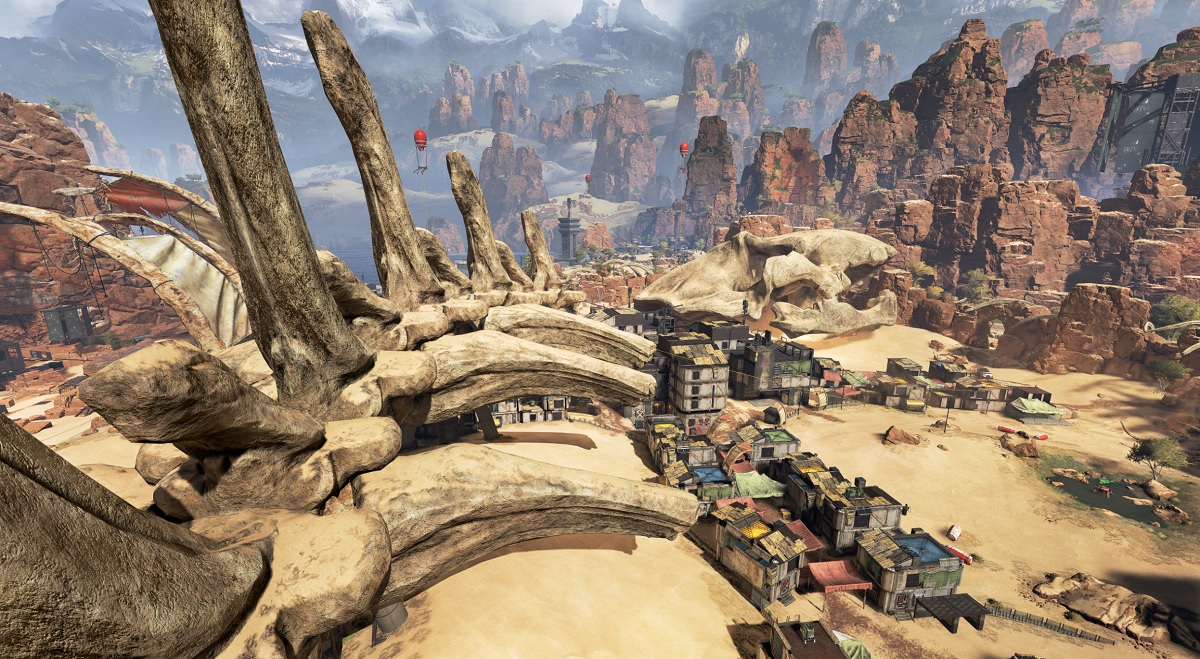
Above: This part of the Apex Legends Kings Canyon map is pretty dry.
GamesBeat: Destructability is not one of your values.
McCandlish: Yeah, it hasn’t been a part of our games.
GamesBeat: What about the Titans? Where are the Titans?
McCandlish: We use a very creative, exploratory, prototype-ey form of development, action blocks. We started with everything on the table, everything we’d discovered making Titanfall and Titanfall 2. Things that shipped and things that hadn’t shipped. We were prototyping many things, not just battle royale. Battle royale comes along, we start making battle royale, of course we’re going to do Titanfall, right? You’ll have a Titan and you’re the pilot and you’ll run around in as big a map as we could make back then with 18 players.
What we discovered was — battle royale has a lot of analogies to poker. There’s chip leader and tightening. There’s ante. We discovered that Titans were a bit too much like having three or four cards in Texas hold ‘em. It didn’t feel fair to go up against a Titan in the last circle if you hadn’t had a chance to find a Titan. It felt more like something was happening to you. The inherent competitive fairness of battle royale was threatened.
We discovered that Titans were more appropriate for a limited time thing, not being core to the mode. That’s an example where, yes, we tried to buck the conventions of battle royale, but convention won, you know? We’re making something that you can play for thousands of hours and master it. You can’t feel like you got cheated because of the inherent randomness of the game. There has to be a fair randomness. Everybody has to be able to see and anticipate the randomness.
We’ll put a supply ship out there that anybody can jump on with better loot, because everybody has the same chance to make that jump and get to it. It’s fair for everybody. It doesn’t control the entire outcome of the match, the way getting a giant robot war machine does. It’s not a knock on the Titans. Titans are great. But they weren’t a great fit for our battle royale.
http://https://youtu.be/AAnNYJAuJow
GamesBeat: As far as monetization, Fortnite’s great achievement was creating things people really wanted to buy. How have you thought about that part? You’re avoiding some of the monetization that’s proven to be a problem. But you still want some things to be desirable enough that people pay for them.
McCandlish: We’re not pay-for-power. We’re a very ethical form of monetization, where we’re giving away a lot of cosmetics that you don’t even have to pay for. If you do want to buy, you can directly buy, from the store, a limited-time item. You can earn the characters in the game or you can buy them. We’re shipping with eight. Six are free and two are earnable. It’s a balancing act, but we knew we didn’t want to be pay-for-power, pay-to-win.
I think we’ve demonstrated with our previous games that we care about having an ethical, transparent relationship with the consumer. We did free DLC maps for Titanfall 2. When the competition was already going pay-for-power back then, we didn’t do that. I think this continues that trend, and I think it’s true to Respawn’s ideals of having a fair relationship with the consumer.
GamesBeat: They mentioned this morning that you put the whole company on it. Why did it merit that decision?
McCandlish: That’s not the case. The entire Apex Legends team, previously the Titanfall team, worked on it for all of 2018. Previous to that, there was a lot of different stuff being tried. Frontier Defense was still ongoing, and live support for Titanfall 2. Then for all of 2018 the entire Titanfall team was on it, but not all of Respawn. Respawn has other games too.
GamesBeat: So it’s just all of the Titanfall team.
McCandlish: Yes, yes.
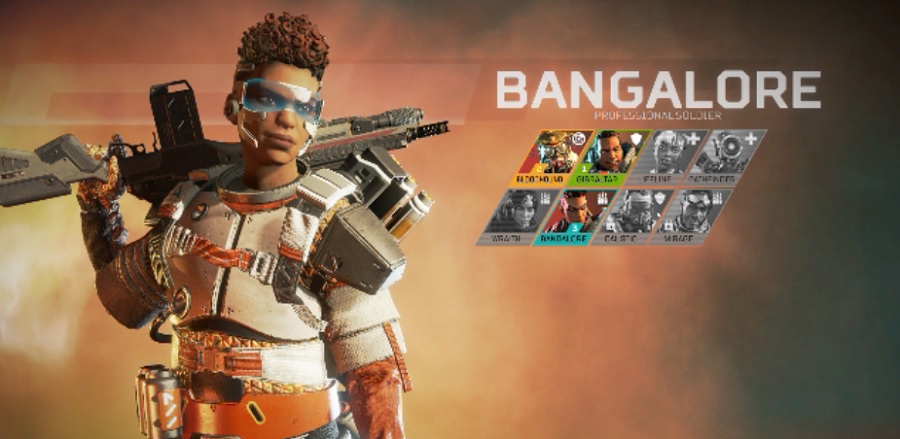
Above: Bangalore is one of the characters in Apex Legends.
GamesBeat: So you jumped on this opportunity, but you didn’t necessarily stop all these other things.
McCandlish: It’s a very organic process. Live support for Titanfall 2 was already ongoing. It was just one guy making a map and another guy putting the mode in at first, back in late March or early April of 2017. It wasn’t until after Frontier Defense shipped that we had some more bandwidth. Those guys then joined our nascent battle royale.
Some of them started discovering characters, which was a separate track. There were independent tracks. We wanted to explore characters, explore battle royale, and explore some other things. Eventually, one by one, those other things went away, and that energy went into battle royale. The cool thing about that was it let us discover battle royale with a reasonable amount of brains trying to get on the same page at the same time, rather than what we experienced on the first Titanfall, where it was — here’s a triple-A team that just finished Modern Warfare 2. We’re going to throw them in a room with no computers, no tech, hire another bunch of guys from God of War, and let’s figure out a game really fast.
GamesBeat: So this was quick, but you didn’t feel like it was rushed.
McCandlish: Exactly. It had time to breathe and find its own character, its own personality. Then, as people were added on, they got to bring their own twists to it and grow it in the direction it was going.
GamesBeat: Was there any sort of interesting change with EA’s ownership? Were they able to put more resources into this that you wouldn’t have had otherwise?
McCandlish: I like to think of it as — we created Titanfall, but that wouldn’t have been possible without the support of EA, letting us make our own new IP. “Go do whatever you want to do.” This first seven years or whatever was like an extended dating period. We got to learn how each other works. Do we want to keep this relationship going? We got to a point where, okay, it’s working, let’s do it.
By becoming part of EA, that’s enabled us to lean into some of the resources that are more private to EA. It’s enabled us to bring in some people like Fred and Sam from the EA side. We’ve brought them internal so they can help us be even more effective working with the different parts of EA. There are other things, like how we do motion capture, where we’ve been able to lend our talents to them and grow. That’s been a really natural, healthy improvement.
But to directly answer the question, no, they didn’t say anything like, “Now you have to have more people.” We scope with the people we have. We see places where we’re missing some type of talent and we go and hire, even if it takes a long time to find the right person for the role and change the team over time.

